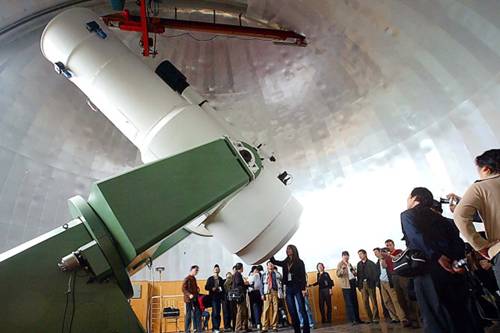|
CHINA SCIENCE AND TECHNOLOGY
NEWSLETTER
The Ministry of Science and Technology
People's Republic of China
|
|
|
N0.569 |
December 30, 2009 |
|
|
|
|
|
|
|
|
IN THIS ISSUE
|
|
*Joint Venture for Large Aircraft Engine
*Cloud Computing Collaboration
*Near-Earth Telescope in Operation
*Database Telling Human Evolution Story
*Mini Cyclotron Accelerator
*New Nuclear Power Station
*Probe Heads for Moon Next Year
|
|
INTERNATIONAL COOPERATION |
Joint Venture for Large Aircraft Engine

Home made airliner (C919).
Aviation Industry Corporation of China, Commercial Aircraft Corporation of China, and CFM International jointly inked an accord on December 21, 2009 to equip the C919 model, a large airplane developed by Commercial Aircraft Corporation of China, with the LEAP-X1C engine developed and manufactured by CFM International in China. The development makes the LEAP-X1C engine the only foreign made driving system employed by the C919 model. Commercial Aircraft Corporation of China plans to launch the maiden flight of C919 in 2014, and put it into official operation in 2016.
Renewable Hybrid Engine
Guangxi based Yuchai Group made the debut on December 21, 2009 of the world’s first hybrid engine using renewable compressed air, a product developed in collaboration with the scientists at Brunel University in the UK. Built with the existing components and parts, the novel auto engine is able to produce renewable compressed air with a fine energy efficiency ratio. The application of the new engine in an urban area may save fuel oil by 6% or more. The low carbon design also allows an annual saving of 200,000 liters of diesel oil for running 1,000 buses, equivalent to 600 tons of CO2 emissions. The improved performance compensates the engine using the recovered compressed air when working at a low speed or for a speedy pick-up. Reduced maintenance and costs are among other merits that the new engine enjoys.
Cloud Computing Collaboration
Beijing University of Technology and IBM jointly announced on December 14, 2009 that they will work together to establish a cloud computing platform, in an attempt to provide high performance computing resources for universities, industry, government, and open communities. Financed by the Beijing Municipal Government, the platform is designed to provide services for campus research, industrial R&D activities, and municipal projects, promoting distant computing resources sharing, and establishing a cloud computing platform that will eventually replace the traditional data center, using visualized hardware, standardized computer programs, automated system management, and streamlined service procedures.
Near-Earth Telescope in Operation

A Schmidt Near-Earth Objects Telescope.
A Schmidt Near-Earth Objects Telescope, developed by the Purple Mountain Observatory, part of the Chinese Academy of Sciences, passed an approval check on December 26, 2009. Built as a Schmidt optic device, the telescope is equipped with a 1.04m master lens, and a 1.2m spherical reflex mirror for enhanced view and light input. The new device enjoys an enhanced capability thanks to the application of advanced CCD sounder, the most sensitive CCD sounder so far developed by the Purple Mountain Observatory in the country, allowing astronomers to shot the pictures of stars in the very dark deep space.
According to a briefing, the new telescope is designed to search minor planets and near-earth celestial objects and assess their risks. Up to data, astronomers at the Observatory have sent the data of more than 70,000 minor planets collected from some 300,000 observation sessions to the Minor Planet Center. Meanwhile, Chinese astronomers have found 721 new minor planets with provisional designations, and named a new comet P/2007S1(ZHAO).
Database Telling Human Evolution Story
CHENG Feng and coworkers at CAS Beijing Genomics Institute studied gene divisions of different human races and associated natural selections from three aspects: chromosomal regions, functional genes, and individual SNP sites, using HapMap data. They screened out selection signals under different indicators, including HET, Win_HET, FST, Win_FST, iHS, ES_HET, ES_FST, and P_iHS, and had them compared and verified under the same framework, so as to collect the needed information. The effort has led to the establishment of SNP@Evolution , an integrative and hierarchical database focusing on positive selection of human genome. SNP@Evolution has been visited more than 10,000 times by researchers from several dozen countries or regions since it was reported in BMC Evol Biol in late September 2009. It becomes a useful tool for researchers to spot selection signals.
SNP@Evolution provides two user interfaces: data query and data visualization, including both HapMap phase II and III data results. Phase II results contain 3,619,226 SNPs and 21,859 gene analysis data. 1,606 chromosomal regions revealed selection signals, and 660 regions division signals. Phase III results present 1,389,498 SNPs and 21,859 valid gene data. 10,138 chromosomal regions selected and 464 chromosomal regions showing strong divisions were sorted out from 11 races. SNP@Evolution provides easy links to other relevant databases for further reference.
Tibetan Antelope Genome Sequenced
Scientists at Qinghai University and Beijing Genomics Institute (Shenzhen) jointly announced on December 25, 2009 that they have sequenced the genome of Tibetan antelope at a hospital affiliated to Qinghai University. The development creates a ground for studying the plateau creatures at the genome level, allowing China to have an enhanced research capability in the areas of high altitude medical science, species evolution, biodiversity, and climate change. Researchers will further study the Tibetan antelope at a genome level, including identifying the functional elements and decrypting the genetic information in the genome, in an attempt to understand Tibetan antelope’s evolution and adaptation to the harsh environment.
Launched in April 2009 in Shenzhen, the Tibetan antelope genome project is part of China’s genome program designed for the socalled three major polar animals (penguin, polar bear, and Tibetan antelope).
Mini Cyclotron Accelerator
A mini cyclotron accelerator, developed by China Institute of Atomic Energy, passed an approval check on December 27, 2009. With endpoint energy at 10 MeV, the mini accelerator is able to speed up negative hydrogen ions, and obtain 10 MeV proton beams, with an internal target beam intensity reaching 430μA. The device will become a new platform to develop advanced mini cyclotron accelerators. It also makes a technical support for developing a cyclotron accelerator at the 100MeV level.
According to experts, the new device constitutes an integrated technical platform for testing high intensity cyclotron accelerators, though it can also be used to develop a cyclotron accelerator at the 100MeV level or to study advanced high intensity cyclotron accelerator technologies. The development creates a ground for developing PET mini cyclotron accelerators that can diagnose malignant tumors and cardiocerebrovascular diseases. The technologies derived from the effort will find applications in developing mA level high intensity cyclotron accelerators, and in national security as well. Meanwhile, it creates a valuable technical ground for developing isotope cyclotron accelerators at the 20-30MeV level, proton therapeutic cyclotron accelerators at 230MeV, and high intensity cyclotron accelerators at the 100MeV level.
±800 Kilovolt DC Converter
An ±800 kilovolt DC power transmission system running from Yunnan to Guangdong, the first of its kind in the world, was put into operation on December 28, 2009. The development makes the DC power transmission between Yunnan and Guangdong reach 2.6 million kilowatts on the day, boosted South Grid to a capacity over 23 million kilowatts, including its thirteen 500 kilovolt west-to-east power transmission lines.
South Grid, working together with a number of collaborators both at home and abroad, rolled out the world’s first 800 kilovolt high end DC converter, first 21m long DC wall piping, and first 75mH air core smoothing reactor, along with a range of technical solutions for DC operations and control strategy, high altitude converter station insulation, and 300-ton unit equipment shipment. Chinese researchers also developed the proprietary specifications and standards for ultra-high voltage DC transmission, also the first of its kind in the world.
Red Florescence Powder
Not long ago, researchers at Changchun Institute of Applied Chemistry, part of the Chinese Academy of Sciences, achieved a breakthrough in developing red florescence powder that can be used in light-emitting diode. The patented technology can find applications in illumination, display, and backlighting.
Researchers produce the phosphate based red florescence powder, using Eu as an activation agent. The new florescence powder presents fine triggering belts and emitting peaks for GaN light source, able to emit red light under GaN light source. Meanwhile, the red florescence powder can be prepared using simple techniques and cheap raw materials at a low cost, enjoying stable chemical properties while causing no harmful effects on environment. As a result, the new red florescence powder expects a promising application perspective.
New Nuclear Power Station
A new nuclear power station opened its phase I project on December 28, 2009 in Haiyang, a junction area sitting between Qingdao, Yantai, and Weihai in Shandong. Physically located on a site facing the ocean in three directions, the nuclear power station will be equipped with six nuclear generators at the mega kilowatt level, enjoying some room for future scalability. Designed with an annual capacity for 17.5 billion kilowatt hours of electricity, Phase I project will have two 1.25 million kilowatt AP 1000 nuclear generators, which will be put into operation in May 2014 and March 2015 respectively. The new nuclear power station, upon the completion of construction, expects to reduce CO2 emissions by more than 50 million tons, nitrogen oxides 150,000 tons, and dust 120,000 tons.
Probe Heads for Moon Next Year
According to a briefing, Chinese scientists have completed the development of Chang’e II satellite, a moon probe that will be launched at the end of 2010. The phase II moon probe that will launch both Chang’e II and III satellites has seen a smooth progress. Chang’e II satellite, currently in assembly, is a lead technical satellite designed to test the key technologies needed for Chang’e III satellite soft landing on the moon, and to obtain high precision images of the lunar area where Chang’e III satellite will land.
Researchers have developed six key technologies for Chang’e II satellite, including earth-moon transfer orbit launch, X-frequency control, near-moon capture, moon circling orbit control, deep space measuring and communication, and high resolution 3-D camera. In the past year, the new satellite has gone through several phases, including key technology development, prototype making, and product validation, and is currently assembled as a whole before being tested on the ground. The launch vehicle that will send the satellite into space is also under development and test, with other application systems, including launching, control, and ground application, getting prepared as scheduled.
Petaflop Computer Home in Tianjin
Tianhe I, China’s first petaflop computer, ranking 5th in the world and 1st in Asia, has found its home in the Binhai New Area, part of Tianjin. Made up of 8 mainframes, 256 computation modules, and other components, the new supercomputer, able to perform 100 trillion floating-point operations per second, will be put into operation in January 2010. It will start to provide services to clients, once it completes the needed tests and tuning. Other application systems will be delivered to the same site in the near future. The new supercomputer expects to be put into full operation in the second half of 2010.
Tianhe I will start to provide services to clients in January 2010, allowing computer programs being deployed according to clients’ requirements, or clients to install their own application programs in the system. The new supercomputer is desirable for the applications in the areas of oil-gas exploration related data processing, biopharmaceutical study, aeronautics and space equipment making, resources prospecting and satellite based remote sensing data processing, banking data analysis, weather forecast, advanced material development and design, and basic scientific research.
Comments or inquiries on editorial matters or Newsletter content should be directed to:
Department of International Cooperation, MOST 15B, Fuxing Road, Beijing 100862, PR China Tel: (8610)58881360 Fax: (8610) 58881364
http://www.most.gov.cn |

